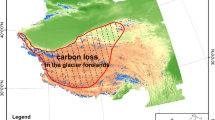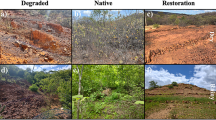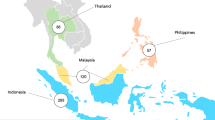Abstract
Succession is defined as changes in biological communities over time. It has been extensively studied in plant communities, but little is known about bacterial succession, in particular in environments such as High Arctic glacier forelands. Bacteria carry out key processes in the development of soil, biogeochemical cycling and facilitating plant colonization. In this study we sampled two roughly parallel chronosequences in the foreland of Midre Lovén glacier on Svalbard, Norway and tested whether any of several factors were associated with changes in the structure of bacterial communities, including time after glacier retreat, horizontal variation caused by the distance between chronosequences and vertical variation at two soil depths. The structures of soil bacterial communities at different locations were compared using terminal restriction fragment length polymorphisms of 16S rRNA genes, and the data were analyzed by sequential analysis of log-linear statistical models. Although no significant differences in community structure were detected between the two chronosequences, statistically significant differences between sampling locations in the surface and mineral soils could be demonstrated even though glacier forelands are patchy and dynamic environments. These findings suggest that bacterial succession occurs in High Arctic glacier forelands but may differ in different soil depths.
Similar content being viewed by others
Log in or create a free account to read this content
Gain free access to this article, as well as selected content from this journal and more on nature.com
or
References
Abdo Z, Schütte UME, Bent SJ, Williams CJ, Forney LJ, Joyce P . (2006). Statistical methods for characterizing diversity of bacterial communities by analysis of terminal restriction fragment length polymorphisms of 16S rRNA genes. Environ Microbiol 8: 929–938.
Archer S, Scifres C, Bassham CR, Maggio R . (1988). Autogenic succession in a subtropical savanna: conversion of grassland to thorn woodland. Ecol Monogr 58: 111–127.
Avis AM, Lubke RA . (1996). Dynamics and succession in coastal dune vegetation in the Eastern Cape, South Africa. Landsc Urban Plan 34: 237–254.
Bain LJ, Engelhardt M . (1991). Introduction to Mathematical Statistics. Duxbury Press: Belmont, CA.
Bais HP, Weir TL, Perry LG, Gilroy S, Vivanco JM . (2006). The role of root exudates in rhizosphere interactions with plants and other organisms. Annu Rev Plant Biol 57: 233–266.
Bardgett RD . (2000). Patterns of below-ground primary succession at Glacier Bay, southeast Alaska. Bull Br Ecol Soc 31: 40–42.
Begon M, Harper JL, Townsend CR . (1996). Ecology: Individuals, Populations and Communities. Blackwell Science: Cambridge.
Bent SJ, Forney LJ . (2008). The tragedy of the uncommon: understanding limitations in the analysis of microbial diversity. ISME J 0: 1–17.
Bernstein L, Bosch P, Canziani O, Chen Z, Christ R, Davidson O . (2007). Climate Change 2007: Synthesis Report. http://www.ipcc.ch/.
Bhatia M, Sharp M, Foght J . (2006). Distinct communities exist beneath a High Arctic polythermal glacier. Appl Env Microbiol 72: 5838–5845.
Blackwood CB, Hudleston D, Zak DR, Buyer JS . (2007). Interpreting ecological diversity indices applied to terminal restriction fragment length polymorphism data: insights from simulated microbial communities. Appl Environ Microbiol 73: 5276–5283.
Bormann BT, Sidle RC . (1990). Changes in productivity and distribution of nutrients in a chronosequence at Glacier Bay National Park, Alaska. J Ecol 78: 561–578.
Breen K, Lévesque E . (2006). Proglacial succession of biological soil crusts and vascular plants: biotic interactions in the High Arctic. Can J Bot 84: 1714–1731.
Brown JH, Lomolino MV . (1998). Biogeography. Sinauer Associates Inc.: Sunderland, MA.
Burnham KP, Anderson DR . (2002). Model Selection and Multimodel Inference: A Practical Information Theoretic Approach 2nd edn. Springer: New York, USA.
Calinski RB, Harabasz J . (1974). A dendrite method for cluster analysis. Commun Stat 3: 1–27.
Cotner JB, Biddanda BA . (2002). Small players, large role: microbial influence on biogeochemical processes in pelagic aquatic ecosystems. Ecosystems 5: 105–121.
Deiglmayr K, Phillippot L, Tscherko D, Kandeler E . (2006). Microbial succession of nitrate-reducing bacteria in the rhizosphere of Poa alpina across a glacier foreland in the Central Alps. Environ Microbiol 8: 1600–1612.
del Moral R, Jones C . (2002). Vegetation development on pumice at Mount St. Helens, USA. Plant Ecol 162: 9–22.
Drake JA . (1991). Community-assembly mechanics and the structure of an experimental species ensemble. Am Nat 137: 1–26.
Duda RO, Hart PE . (1973). Pattern Classification and Scene Analysis. John Wiley: New York, NY, USA.
Efron B, Tibshirani RJ . (1993). An Introduction to the Bootstrap. Chapman and Hall: New York.
Fastie CL . (1995). Causes and ecosystem consequences of multiple pathways of primary succession at Glacier Bay, Alaska. Ecology 76: 1899–1916.
Fitzharris BB . (1996). The cryosphere: changes and their impacts. In: Houghton JT, Filho LGM, Callander BA, Harris N, Kattenberg A, Maskell K (eds). Climate Change 1995: The Science of Climate Change. Cambridge University Press: Cambridge, UK, pp 241–265.
Godwin H . (1929). The sub-climax and deflected succession. J Ecol 17: 144–147.
Green J, Bohannan BJM . (2006). Spatial scaling of microbial diversity. Trends Ecol Evol 21: 501–507.
Green J, Holmes AJ, Westoby M, Oliver I, Briscoe D, Dangerfield M . (2004). Spatial scaling in microbial eukaryote diversity. Nature 432: 747–750.
Gregory PJ . (2007). Plant Roots: Their Growth, Activity, and Interaction with Soils. Blackwell Publishing: Oxford, UK.
Grundmann GL, Normand P . (2000). Microscale diversity of the genus Nitrobacter in soil on the basis of analysis of genes encoding rRNA. Appl Env Microbiol 66: 4543–4546.
Harland WB . (1997). The Geology of Svalbard. The Geological Society: Bath, UK.
Hodkinson ID, Coulson SJ, Harrison J, Webb NR . (2001). What a wonderful web they weave: spiders, nutrient capture and early ecosystem development in the High Arctic—some counter-intuitive ideas on community assembly. Oikos 95: 349–352.
Hodkinson ID, Coulson SJ, Webb NR . (2003). Community assembly along proglacial chronosequences in the high Arctic: vegetation and soil development in north-west Svalbard. J Ecol 91: 651–663.
Hodkinson ID, Webb NR, Coulson SJ . (2002). Primary community assembly on land-the missing stages: why are heterotrophic organisms always there first? J Ecol 90: 569–577.
Horner-Devine MC, Lage M, Hughes JB, Bohannan BJM . (2004). A taxa-area relationship for bacteria. Nature 432: 750–753.
Huang PM, Wang MK, Chiu CY . (2005). Soil mineral-organic matter-microbe interactions: impacts on biogeochemical processes and biodiversity in soils. Pedobiologia 49: 609–635.
Huston M, Smith T . (1987). Plant succession: life history and competition. Am Nat 130: 168–198.
Insam H, Haselwandter K . (1989). Metabolic quotient of the soil microflora in relation to plant succession. Oecologia 79: 174–178.
Inubushi K, Acquaye S . (2004). Role of microbial biomass in biogeochemical processes in paddy soil environments. Soil Sci Plant Nutr 50: 793–805.
Johnson D, Booth RE, Whiteley AS, Bailey MJ, Read DJ, Grime JP et al. (2003). Plant community composition affects the biomass, activity and diversity of microorganisms in limestone grassland soil. Eur J Soil Sci 54: 671–677.
Johnson EA, Miyanishi K . (2008). Testing the assumptions of chronosequences in succession. Ecol Lett 11: 419–431.
Jumpponen A . (2003). Soil fungal community assembly in a primary successional glacier forefront ecosystem as inferred from rDNA sequence analyses. New Phytol 158: 569–578.
Kandeler E, Deiglmayr K, Tscherko D, Bru D, Philippot L . (2006). Abundance of narG, nirS, nirK, and nosZ genes of denitrifying bacteria during primary successions of a glacier foreland. Appl Environ Microbiol 72: 5957–5962.
Kastovska K, Elster J, Stibal M, Santruckova H . 2005. Microbial assemblages in soil microbial succession after glacier retreat in Svalbard (high arctic). Microbiol Ecol 50: 396–407.
Kaufmann R . (2001). Invertebrate succession on an alpine glacial foreland. Ecology 82: 2261–2278.
Kloepper JW, Rodriguez-Ubana R, Zehnder GW, Murphy JF, Sikora E, Fernández C . (1999). Plant root-bacterial interactions in biological control of soilborne diseases and potential extension to systemic and foliar diseases. Australas Plant Pathol 28: 21–26.
Kuske CR, Ticknor LO, Miller ME, Dunbar JM, Davis JA, Barns SM et al. (2002). Comparison of soil bacterial communities in rhizospheres of three plant species and the interspaces in an arid grassland. Appl Env Microbiol 68: 1854–1863.
Legendre P, Gallagher ED . (2001). Ecologically meaningful transformations for ordination of species data. Oecologia 129: 271–280.
Lipson DA, Schmidt SK, Monson RK . (1999). Links between microbial population dynamics and nitrogen availability in an alpine ecosystem. Ecology 80: 1623–1631.
Liu WT, Marsh TL, Cheng H, Forney LJ . (1997). Characterization of microbial diversity by determining terminal restriction fragment length polymorphisms of genes encoding 16S rRNA. Appl Env Microbiol 63: 4516–4522.
Matthews JA . (1992). The Ecology of Recently-Deglaciated Terrain: A Geoecological Approach to Glacier Forelands and Primary Succession. Cambridge University Press: New York, NY.
McCune B, Allen TFH . (1985). Will similar forests develop on similar sites? Can J Bot 63: 367–376.
Miles J, Whalton DWH . (1993). Primary Succession on Land. Blackwell Scientific Publications: Oxford.
Mukerji KG, Manoharachary C, Singh J . (2006). Microbial Activity in the Rhizosphere. Springer Verlag: Berlin, Heidelberg, New York.
Nemergut DR, Anderson SP, Cleveland CC, Martin AP, Miller AE, Seimon A et al. (2007). Microbial community succession in an unvegetated, recently deglaciated soil. Microbiol Ecol 53: 110–122.
Nicol GW, Tscherko D, Embley TM, Prosser JI . (2005). Primary succession of soil Crenarchaeota across a receding glacier foreland. Environ Microbiol 7: 337–347.
Noguez AM, Arita HT, Escalante AE, Forney LJ, Garcia-Oliva F, Souza V . (2005). Microbial macroecology: highly structured prokaryotic soil assemblages in a tropical deciduous forest. Global Ecol Biogeogr 14: 241–248.
Oda Y, Star B, Huisman LA, Gottschal JC, Forney LJ . (2003). Biogeography of the purple nonsulfur bacterium Rhodopseudomonas palustris. Appl Env Microbiol 69: 5186–5191.
Ohtonen R, Fritze H, Pennanen T, Jumponen A, Trappe J . (1999). Ecosystem properties and microbial community changes in primary succession on a glacier forefront. Oecologia 119: 239–246.
Rutigliano FA, D'Ascoli R, Maggi O, Gentile A, Persiani AM . (2005). Diversity, activity and biomass of soil microbial community of Mediterranean environment as affected by plant cover. Geophys Res Abstr 7.
Sarle WS . (1983). The Cubic Clustering Criterion. SAS Institute Inc: Cary, NC.
Schipper LA, Degens BP, Sparling GP, Duncan LC . (2001). Changes in microbial heterotrophic diverstiy along five plant successional sequences. Soil Biol Biochem 33: 2093–2103.
Sigler WV, Crivii S, Zeyer J . (2002). Bacterial succession in glacial forefield soils characterized by community structure, activity and opportunistic growth dynamics. Microb Ecol 44: 306–316.
Sigler WV, Zeyer J . (2002). Microbial diversity and activity along the forefields of two receding glaciers. Microb Ecol 43: 397–407.
Skidmore ML, Foght JM, Sharp MJ . (2000). Microbial life beneath a High Arctic glacier. Appl Env Microbiol 66: 3214–3220.
Tscherko D, Hammesfahr U, Marx MC, Kandeler E . (2004). Shifts in rhizoshpere microbial communities and enzyme activity of Poa alpina across and alpine chronosequence. Soil Biol Biochem 36: 1685–1698.
Tscherko D, Rustemeier J, Richter A, Waner W, Kandeler E . (2003). Functional diversity of the soil microflora in primary succession across two glacier forelands in the Central Alps. Eur J Soil Sci 54: 685–696.
Turicchia S, Ventura S, Schütte UME, Soldati E, Zielke M, Solheim B . (2005). Biodiversity of the cyanobacterial community in the foreland of the retreating glacier Midre Lovénbreen, Spitsbergen, Svalbard. Arch Hydrobiol Suppl 117: 427–440.
Vestal RJ . (1993). Cryptoendolithic communities from hot and cold deserts: Speculation on microbial colonization and succession. In: Miles J, Whalton DWH (eds). Primary Succession on Land. Special Publication Number 12 of the British Ecological Society. Blackwell Scientific Publications: Oxford, pp 5–16.
Walker LR, del Moral R . (2003). Primary Succession and Ecosystem Rehabilitation. Cambridge University Press: New York, NY.
Wynn-Williams DD . (1993). Microbial processes and initial stabilization of fellfield soil. In: Miles J, Whalton DWH (eds). Cryptoendolithic Communities from Hot and Cold Deserts: Speculation on Microbial Colonization and Succession. Blackwell Scientific Publications: Oxford, pp 17–32.
Zhou X, Brown CJ, Abdo Z, Davis CC, Hansmann MA, Joyce P et al. (2007). Differences in the composition of vaginal microbial communities found in healthy caucasian and black woman. ISME J 1: 121–133.
Acknowledgements
The fieldwork was funded by the Amundsen Center at the University of Tromsø and the Norwegian Polar Institute. The DNA Sequence Analysis Core Facility at the University of Idaho is supported by an NIH Center of Biomedical Research Excellence grant (P20 RR016448) from the National Center for Research Resources to LJF. We thank Dr Rolf A Olsen and the University Centre in Svalbard (UNIS) for facilitating our field research, and Dr Ian Hodkinson and Dr Steve Coulson for information on their sampling locations and valuable discussions. We also wish to acknowledge Dr Eva Top for advice on methods for DNA isolation, Richard Pendegraft for help with statistical analyses, and Dr Matthias Zielke, Dr Stefano Ventura and Silvia Turichia for their assistance in the field. Finally, we appreciate the helpful comments on the article provided by Dr Kari Segraves and Dr Patrick Kuss.
Author information
Authors and Affiliations
Corresponding author
Additional information
Supplementary Information accompanies the paper on The ISME Journal website (http://www.nature.com/ismej)
Supplementary information
Rights and permissions
About this article
Cite this article
Schütte, U., Abdo, Z., Bent, S. et al. Bacterial succession in a glacier foreland of the High Arctic. ISME J 3, 1258–1268 (2009). https://doi.org/10.1038/ismej.2009.71
Received:
Revised:
Accepted:
Published:
Issue date:
DOI: https://doi.org/10.1038/ismej.2009.71
Keywords
This article is cited by
-
Bacterial community network complexity and role of stochasticity decrease during primary succession
Soil Ecology Letters (2024)
-
Biogeographical patterns and mechanisms of microbial community assembly that underlie successional biocrusts across northern China
npj Biofilms and Microbiomes (2021)
-
Distinct Characteristics of Bacterial Community in the Soil of Nanshazhou Island, South China Sea
Current Microbiology (2020)
-
A global synthesis of biodiversity responses to glacier retreat
Nature Ecology & Evolution (2019)
-
Soil microbiomes with distinct assemblies through vertical soil profiles drive the cycling of multiple nutrients in reforested ecosystems
Microbiome (2018)



